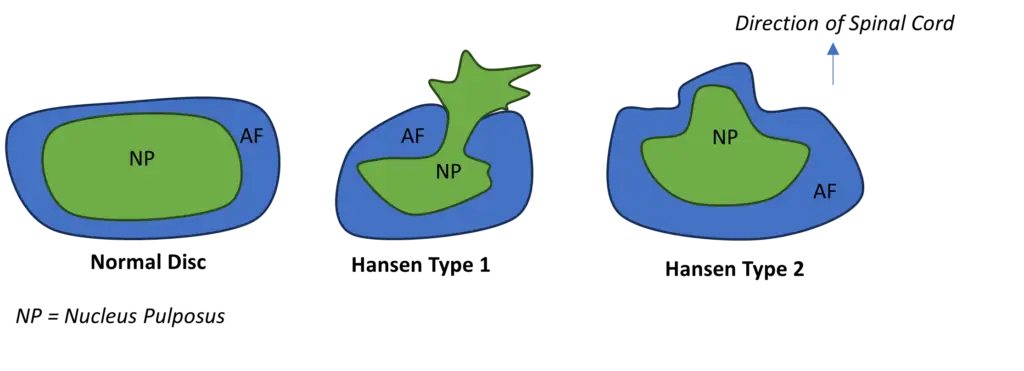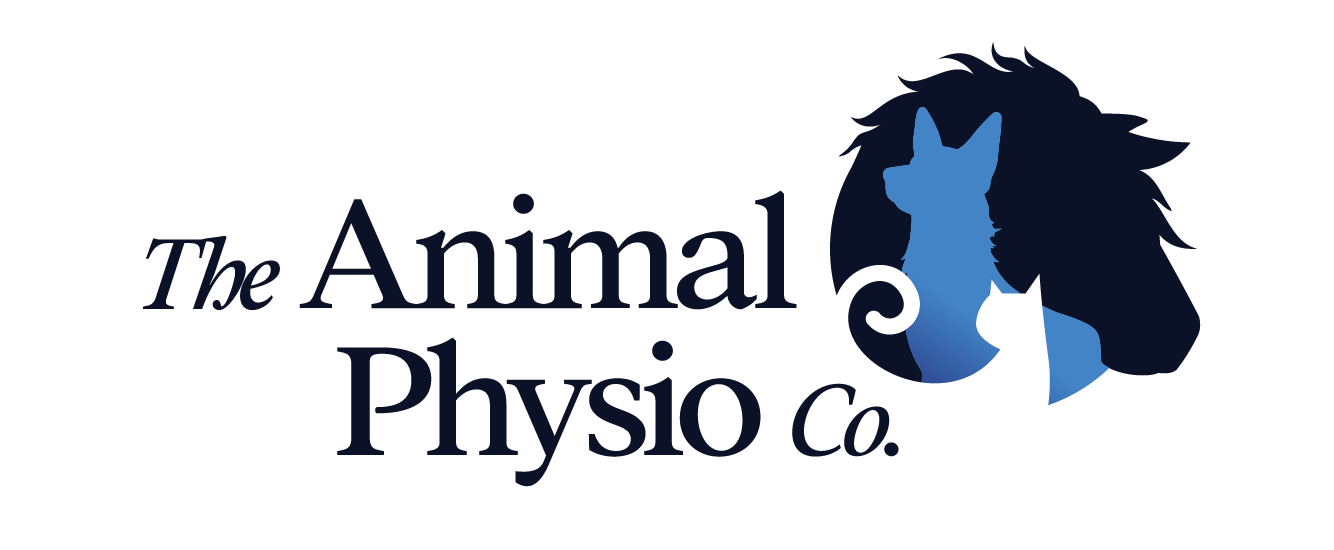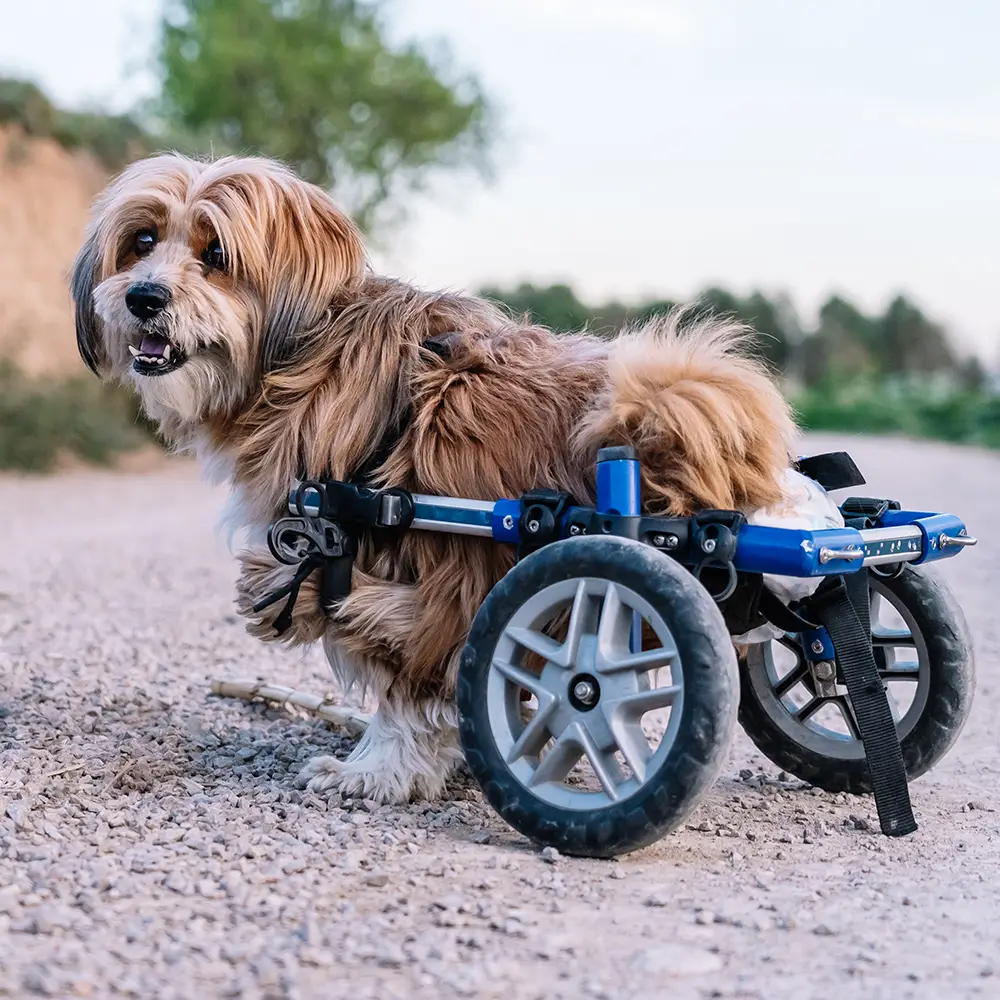Intervertebral Disc Disease (IVDD) is a common spinal condition involving the spinal disc degeneration/herniating that affects many varieties of dog. A normal intervertebral disc is made up of an outer layer which is tough and fibrous, the annulus fibrosus, and an inner gel-like layer called the nucleus pulposus. These discs lie between the vertebrae in the spine and act as shock absorbers and protective structures while. still allowing for slight spinal mobility. IVDD is a debilitating condition can cause pain, loss of mobility, and, if left untreated, may lead to severe neurological issues. In recent years, physiotherapy has emerged as a valuable and effective component of the treatment plan for dogs with IVDD. In this blog post, we’ll explore what IVDD is, its symptoms, and how physiotherapy can play a crucial role in the rehabilitation of dogs affected by this condition.
The Disease
There are three types of IVDD, which are classified as follows:
Hansen Type 1: Nucleus pulposus degeneration and extrusion. This is a hereditary degeneration of the nucleus pulposus that occurs mostly in smaller dogs with shorter legs (often legs which aren’t straight – chondrodystrophic) and relatively longer backs. It typically occurs in younger dogs (3-7 years-old) and breeds such as Dachshunds, Bassets, Corgis, Pekingese, and Maltese Poodles are overrepresented. Although this often appears to happen suddenly, it is actually the result of chronic degeneration.
Hansen Type 2: Annulus fibrosis degeneration and extrusion. This type of disc usually happens in older dogs (8-12 years-old) and is caused by a long-term degeneration of the annulus fibrosis that results in a slow onset and progression of symptoms. It can happen in any dog breed, but certain breeds like Labrador and Golden Retrievers, Dobermanns, St Bernards and Boxers are overrepresented.
Hansen Type 3: Acute, non-compressive nucleus pulposus extrusion (usually as a result of trauma or heavy exercise). Think of the nucleus pulposus exploding outwards all of a sudden and resulting in damage and inflammation within the spinal canal. This is similar to Hansen Type 1 but can usually be traced back to a single event.

IVDD is usually monitored via a grading scale. The below scale was adapted from a scale provided by Dr Marianne Dorn (BVM&S PGCert SART MRCVS) based off of her review of several source materials and scientific studies in Dachshunds.
| Grade | Description | Prognosis with Conservative Management | Surgical Prognosis |
|---|---|---|---|
| Grade 1 | Walking normally but extremely painful, changes to posture and spinal/cervical mobility may be evident | Very Good (70-100%) | Almost 100% Certain |
| Grade 2 | Weak and wobbly walking | Ok to Good (55-100%) | Almost 100% Certain |
| Grade 3 | Unable to walk or stand without assistance but limb awareness still present. | Ok (55-80%) | Very Good (80-90%) |
| Grade 4 | No deliberate or voluntary movement of affected limbs; may or may not have control of bladder/bowels. | Poor to Ok (40-80%) | Good to Very Good (80-90%) |
| Grade 5 | No deep pain in, or awareness of, affected limbs; no voluntary movement or proprioception; may or may not have control of bladder/bowels. | Poor (x<30%) | Ok 50-60% |
Symptoms of IVDD in dogs include but are not limited to:
- Spinal Pain: Dogs with IVDD often experience pain along their back or in their neck, which may manifest as sensitivity to touch, a noticeable arch in the spine and/or reluctance to move.
- Reluctance to Jump, Climb Stairs or Perform Normal Daily Activities: Due to pain and discomfort, dogs may avoid activities that involve jumping or climbing stairs.
- Changes in Gait and Coordination: Affected dogs may have an altered gait, showing signs of weakness and loss of coordination that manifests in a drunken sailor-like gait. This can progress, into difficulties in standing or moving around at all (i.e. paralysis).
- Loss of Bladder/Bowel Control: Some dogs may lose the inability to control their bladder or bowels.
- Other Symptoms: Depending on where in the spine the degeneration occurs, other symptoms can be demonstrated, such as lameness only in one limb or difficulty in turning/lifting the head and neck or wagging the tail. Other symptoms can also be related to IVDD, including frequent vomiting, vocalizing, shivering, hiding and constipation.
Diagnosing IVDD
Intervertebral Disc Disease (IVDD) in dogs is typically diagnosed through a combination of clinical examinations, imaging studies, and neurological assessments. The process often begins with a thorough physical examination by a veterinarian, where they assess the dog’s gait, posture, and overall neurological function. To further evaluate the spinal column, imaging techniques such as X-rays or more advanced tools like magnetic resonance imaging (MRI) may be employed. These imaging studies help visualize the intervertebral discs and identify any abnormalities, such as herniation or compression of the spinal cord.
How Physiotherapy Can Help:
- Pain Management: Physiotherapy can incorporate various modalities, such as massage, laser therapy, TENS, and manual therapy, to alleviate pain and discomfort associated with IVDD.
- Post-Op Guidance: Physiotherapists are equipped with the knowledge to guide owners in the management of post-op cases at home, ensuring that owners stick to vet-approved programs that are engineered to improve outcomes, decrease the likelihood of complications, and shorten recovery times.
- Strengthening and Coordination: Targeted, safe exercises help build muscle strength in the affected areas, providing support to the spine and improving overall mobility.
- Management of Compensation: Physiotherapists use specific movements to maintain and improve joint flexibility, preventing stiffness/contractures and promoting better mobility while slowing the rate of muscle atrophy that occurs as a result of denervation.
- Weight-Loss and Weight-Management: Water-based exercises in a controlled environment can reduce the impact on joints while providing resistance for muscle strengthening, as well as improving cardiovascular fitness and decreasing excess weight. This is not indicated for every patient.
- Hydrotherapy: Water-based exercises in a controlled environment can reduce the impact on joints while providing resistance for muscle strengthening. This is not indicated for every patient.
- General Health and Wellbeing: Trained physiotherapists can assist at every point along the way, from diagnosis and conservative management to pre-op preparation and post-op care. They are able to assess the needs of every patient individually and tailor a plan to suit them. They also should have a range of knowledge on the topics of managing and caring for an IVDD patient, as well as monitoring their progress, that will be invaluable for owners over the long-term.
IVDD can be a challenging condition for both dogs and their owners, but incorporating physiotherapy into the treatment plan of a disc case can significantly improve the chances of recovery. It’s important to consult with a veterinarian to determine the best approach for each individual case. Veterinary physiotherapy, when tailored to the specific needs of the dog, not only addresses pain and discomfort but also plays a pivotal role in enhancing overall well-being and restoring a better quality of life for these cases.
If your dog is struggling with IVDD, consider contacting us to help.




